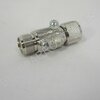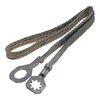QUOTE="ForestRunner98, post: 733461, member: 57126"]Is that almost S9 in noise or were you RX at that moment??[/QUOTE]
Sitting or moving with engine on. A whine that changes according to engine rpm.
S9 is almost always external conditions. The radio shows S3-S5 most times and in most places after dark. Rises with the sun and local activity.
Thru the course of a day, the meter will reflect a background. What’s audible works a little differently.
Here at 0530, it’s easy to very clearly hear any passing trucks on AM-19. As the day gets underway, the space fills with other voices to be adjusted out via RF Gain, Squelch, and adding more DSP Filtration. If Skip comes in the back door, hearing anyone audibly at a distance becomes challenging on AM-19.
Local comms improved. I can “hear” problems in the other man’s set-up such that making guesses about his rig problems became easier.
Yesterday talked on & off with another driver literally all the way across Mississippi and Louisiana. Same company, but he was using factory mounts with a pair of Francis. Others chimed in. Had some oversized loads with pilot cars working. It was easier to make better conversations as less drop-out of words were occurring with guys a mile or more away.
There is a WIDE range of performance from others rigs to consider. Some good, and some almost unbelievably bad.
The whine is present, but not an interference, per se.
Right now, engine-off, all is wide open. Cleaner, when RX starts. (Truck key position makes no change when engine off).
The Bond Experiment (gear cases) cut off some continuous noise spikes. The level of overall noise will rise & fall, but now some static interference (some source spikes) is substantially muted.
I do NOT have an efficient antenna mount.
(I need to get a new phase harness built).
Worth a try.
Another noise experiment is with a WORKMANN Coax Static Bleed (Lighting Arrestor) installed at back of radio. 1/4” braid with hook terminals in a few inches run to ground from device screw. This is to try and cut noise off of the coaxial cable before the transceiver.

Here’s an example from NAPA. Serrated ends. Shortest possible is best. I “shortened” and “joined” my case grounds by aligning them and using a pair of copper split-bolts to hold them tight at length desired, AND in continuous full contact on overlap.

(Recommendation is from the Clays Radio website).
Re DC & RFI: I’ve seen different discussions of grounding radio gear (HAM Base Station with full spectrum gear). Some “daisy-chain” them together AND THEN to a ground point (used as example of what not to do; chasing voltage potentials).
More often is recommended ALL gear separately to a common ground bar.
Here, (11-Meter in Class 8 tractor) three braid straps went to a single union from case screws (except tuner with dedicated ground), thence to the RF ground (only way I could do it with what’s at hand).
“Better” than I did it is probably out there. I’m satisfied it’s worth the trouble in a big truck to see if it helps. (It did).
The DC ground for Radio Power is on the truck frame. POS fused nearby at BATT. 35’ dedicated circuit starts/stops below cab.
As that’s barely enough ampacity to maintain a 3% voltage drop maximum at 10A (and I reckon the system at 20A for planning) establishing a ground in the overhead is another experiment soon to come. One-half the current power cable circuit is “right” for the 10-AWG I’m using. (See MARINCO 3% Voltage Drop AWG Calculator).
Behind the radio gear is this 4-way distribution box. Makes swapping out power easy, not just other gear. I’m using flat duplex cable now. Have some 8-AWG single at home ready to use (Red POS terminated & fused at 20’. I’ll prep a piece of black NEG to run from box to nearby DC ground).

An RF ground a bit of a distance from the DC ground (is this mornings plan). Advice welcomed (as always).
What grounds? How & Where? DC & RF.
.
Sitting or moving with engine on. A whine that changes according to engine rpm.
S9 is almost always external conditions. The radio shows S3-S5 most times and in most places after dark. Rises with the sun and local activity.
Thru the course of a day, the meter will reflect a background. What’s audible works a little differently.
Here at 0530, it’s easy to very clearly hear any passing trucks on AM-19. As the day gets underway, the space fills with other voices to be adjusted out via RF Gain, Squelch, and adding more DSP Filtration. If Skip comes in the back door, hearing anyone audibly at a distance becomes challenging on AM-19.
Local comms improved. I can “hear” problems in the other man’s set-up such that making guesses about his rig problems became easier.
Yesterday talked on & off with another driver literally all the way across Mississippi and Louisiana. Same company, but he was using factory mounts with a pair of Francis. Others chimed in. Had some oversized loads with pilot cars working. It was easier to make better conversations as less drop-out of words were occurring with guys a mile or more away.
There is a WIDE range of performance from others rigs to consider. Some good, and some almost unbelievably bad.
The whine is present, but not an interference, per se.
Right now, engine-off, all is wide open. Cleaner, when RX starts. (Truck key position makes no change when engine off).
The Bond Experiment (gear cases) cut off some continuous noise spikes. The level of overall noise will rise & fall, but now some static interference (some source spikes) is substantially muted.
I do NOT have an efficient antenna mount.
(I need to get a new phase harness built).
Worth a try.
Another noise experiment is with a WORKMANN Coax Static Bleed (Lighting Arrestor) installed at back of radio. 1/4” braid with hook terminals in a few inches run to ground from device screw. This is to try and cut noise off of the coaxial cable before the transceiver.

Here’s an example from NAPA. Serrated ends. Shortest possible is best. I “shortened” and “joined” my case grounds by aligning them and using a pair of copper split-bolts to hold them tight at length desired, AND in continuous full contact on overlap.

(Recommendation is from the Clays Radio website).
Re DC & RFI: I’ve seen different discussions of grounding radio gear (HAM Base Station with full spectrum gear). Some “daisy-chain” them together AND THEN to a ground point (used as example of what not to do; chasing voltage potentials).
More often is recommended ALL gear separately to a common ground bar.
Here, (11-Meter in Class 8 tractor) three braid straps went to a single union from case screws (except tuner with dedicated ground), thence to the RF ground (only way I could do it with what’s at hand).
“Better” than I did it is probably out there. I’m satisfied it’s worth the trouble in a big truck to see if it helps. (It did).
The DC ground for Radio Power is on the truck frame. POS fused nearby at BATT. 35’ dedicated circuit starts/stops below cab.
As that’s barely enough ampacity to maintain a 3% voltage drop maximum at 10A (and I reckon the system at 20A for planning) establishing a ground in the overhead is another experiment soon to come. One-half the current power cable circuit is “right” for the 10-AWG I’m using. (See MARINCO 3% Voltage Drop AWG Calculator).
Behind the radio gear is this 4-way distribution box. Makes swapping out power easy, not just other gear. I’m using flat duplex cable now. Have some 8-AWG single at home ready to use (Red POS terminated & fused at 20’. I’ll prep a piece of black NEG to run from box to nearby DC ground).

An RF ground a bit of a distance from the DC ground (is this mornings plan). Advice welcomed (as always).
What grounds? How & Where? DC & RF.
.
Last edited:


